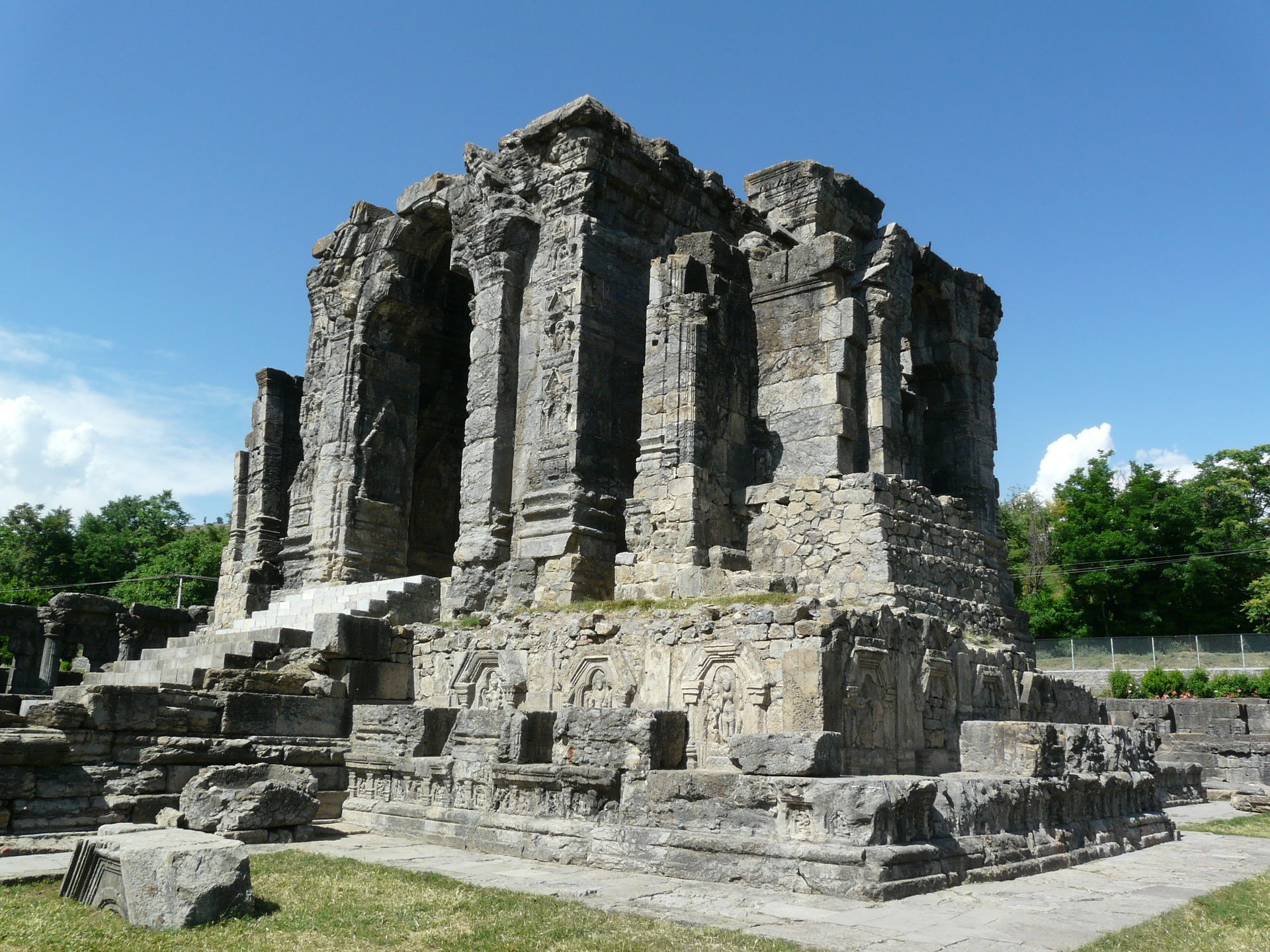Description

Disclaimer: Copyright infringement not intended.
Context
Members of a little-known Hindutva group forced their way into the Archaeological Survey of India (ASI)-protected Martand sun temple recently.
Details
- The Martand Sun Temple, also known as the Martand Surya Mandir, is an ancient Hindu temple dedicated to the Sun God, located near Anantnag in the Indian state of Jammu and Kashmir.
Historical Background
- Construction Period:
- The Martand Sun Temple was built during the 8th century by King Lalitaditya Muktapida of the Karkota Dynasty.
- Architectural Style:
- The temple is a fine example of Kashmiri architecture and is renowned for its grandeur and artistic excellence.
- It reflects a blend of Greek, Roman, Iranian, and Indian architectural styles.
- Political Motivations:
- The construction of the temple by Lalitaditya Muktapida may have had political motivations, aiming to assert his authority and demonstrate the grandeur of his rule
Architecture and Layout
- Design and Layout:
- The temple is situated on top of a plateau, providing a panoramic view of the surrounding mountains.
- It is built in the form of a colonnaded mandapa surrounded by a courtyard.
- Central Shrine:
- The main shrine, dedicated to the Sun God, was originally surrounded by 84 smaller shrines.
- Columns and Carvings:
- The temple has numerous intricately carved columns, depicting various scenes from Hindu mythology.
- The carvings include images of deities, celestial beings, and other mythological figures.
- Influence of Greek Architecture:
- The temple is often compared to classical Greek temples, particularly the Temple of Hercules in Rome, due to its architectural similarities.
- Gandharan, Gupta, and Chinese Influences:
- The architecture of the Martand Sun Temple reflects a fusion of Gandharan, Gupta, and Chinese architectural styles, showcasing the cultural assimilation of the region.
- Peristyle Design:
- The temple's peristyle design, with a central shrine and 84 smaller shrines surrounding it, is a distinctive feature, making it the largest example of a peristyle in Kashmir.
- Entrance and Decorations:
- The temple's western entrance, aligned with the overall perimeter, is grand and elaborately decorated, following the principles of Hindu temple architecture.

Decline
- Destruction:
- The temple faced destruction during the 15th century due to the invasion of Sikander Butshikan, a ruler of the Shah Mir dynasty.
- Sikandar Shah Miri's Role:
- Sikandar Shah Miri's role in the destruction of the temple has been a subject of historical controversy, with different accounts providing varying perspectives.
- Some scholars argue that the destruction was part of Sikandar's broader political strategies rather than solely religious zeal.
- Current State:
- Today, the Martand Sun Temple stands in ruins, with only remnants of its former grandeur. The main structure, however, remains partially intact.
Preservation Efforts
- Archaeological Survey of India (ASI):
- The ASI has been involved in the conservation and maintenance of the temple ruins.
- The ASI's declaration of the Martand Sun Temple as a site of national importance underscores the efforts to preserve and protect the historical and architectural heritage of the temple.
- Tourism and Awareness:
- Efforts have been made to promote tourism and create awareness about the historical and cultural significance of the Martand Sun Temple.
Sun Temples Across Different Regions
- Andhra Pradesh:
- Surya Narayana Temple at Arasavalli: Built in the 7th century by King Devendra Varma, the temple is designed so that on Radhasaptami, the Sun's rays directly fall on the deity's feet.
- Assam:
- Surya Pahar Temple: Constructed in the 9th century at Sri Surya Pahar in Assam.
- Bihar:
- Numerous Sun Temples across Bihar, including Deo Surya Mandir in Deo, Bihar, and Sun Temple at Nalanda.
- Gujarat:
- Modhera Sun Temple: Built in 1027 by King Bhimdev of the Chaulukya dynasty, it is one of the most prominent Sun Temples in India.
- Haryana:
- Several Sun Temples within the 48 Kos Parikrama of Kurukshetra, including Surajkund in Faridabad.
- Jammu and Kashmir:
- Martand Sun Temple: Built in the 10th century near Anantnag, now in ruins due to destruction by Sikandar Shah Miri.
- Karnataka:
- Soorya Narayana Temple at Maroli: Located in Mangalore, Karnataka.
- Kerala:
- Adithyapuram Sun Temple: A Sun Temple in Kerala.
- Madhya Pradesh:
- Bhramanya Dev Temple at Unao, Balaji: Located in Madhya Pradesh.
- Birla Sun Temple in Gwalior: A modern sun temple.
- Manipur:
- Ebudhou Korouhanba Temple: Located in Moidangpok, Patsoi, Manipur.
- Odisha:
- Konark Sun Temple: Also known as the Black Pagoda, a UNESCO World Heritage Site.
- Biranchinarayan Temple, Palia: A 13th-century temple in Palia, Odisha.
- Tamil Nadu:
- Suryanar Kovil Temple at Kumbakonam: Built in 1060-1118 CE.
- Uttarakhand:
- Sun Temple at Katharmal: Built in the 9th century CE by the Katyuri kings, near Almora and Nainital.
- Uttar Pradesh:
- Rahila Sagar Sun Temple at Mahoba: A Sun Temple in Uttar Pradesh.
- Sun Temple at Kalpi: Another Sun Temple in Uttar Pradesh.
- West Bengal:
- Sonatapal, Bankura District: A Sun Temple in West Bengal.
- Gangaditya Temple, Murshidabad District: Another Sun Temple in West Bengal.
- Multan Sun Temple (Aditya Sun Temple):
- Located in Multan, Punjab, Pakistan, it was destroyed by Muslim rulers in the 10th century.

Conclusion
The Martand Sun Temple stands as a testament to the architectural and artistic achievements of ancient Kashmir. Despite facing centuries of decay and destruction, the temple remains a symbol of India's rich cultural heritage. Preservation efforts continue to ensure that future generations can appreciate the historical and architectural significance of this remarkable site.
|
PRACTICE QUESTION
Q. Which region is known for the Sun Temple at Katharmal, built in the 9th century CE by the Katyuri kings?
a) Himachal Pradesh
b) Uttarakhand
c) Sikkim
d) Arunachal Pradesh
Answer: b)
|















